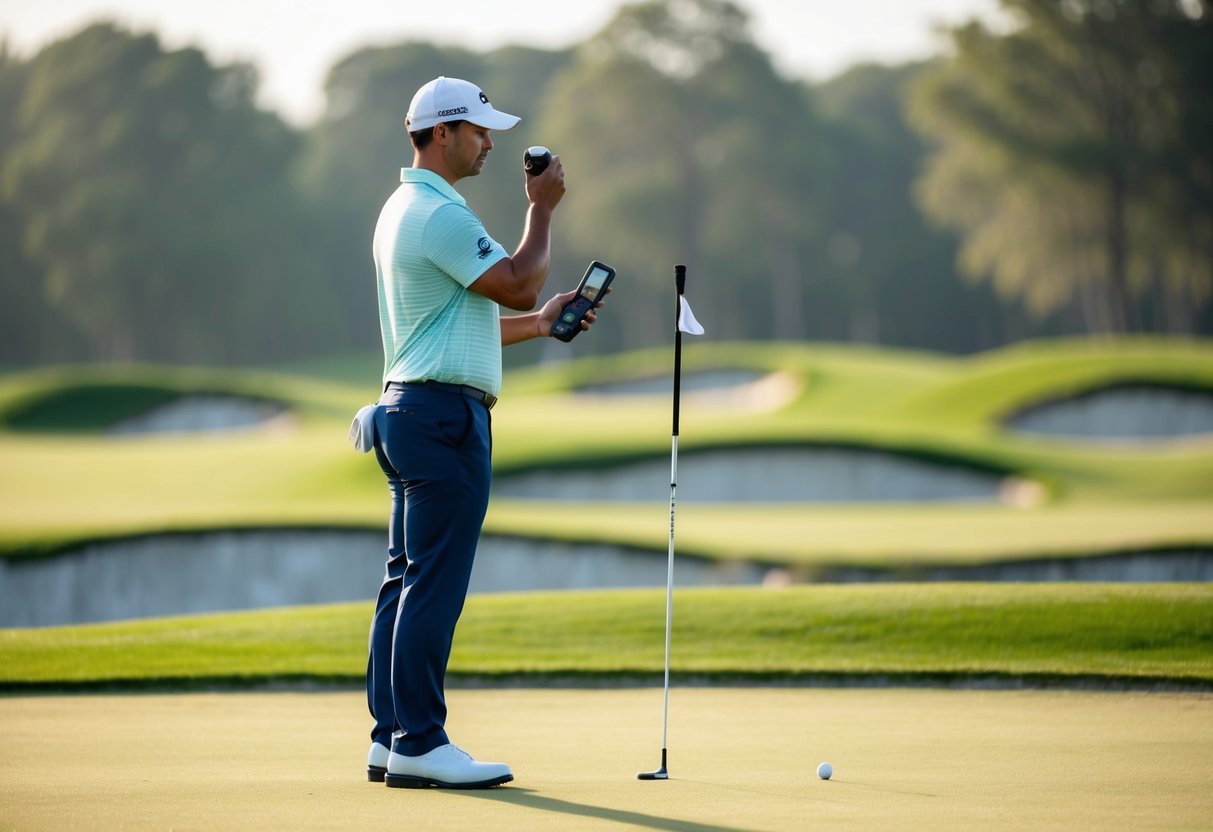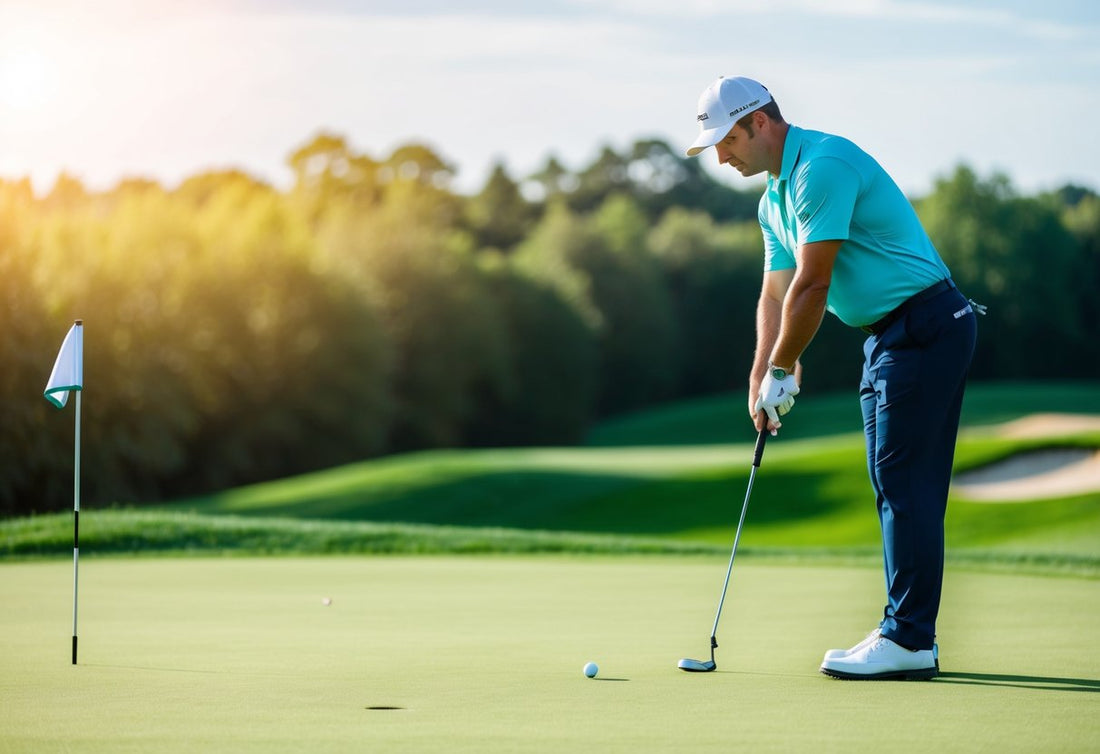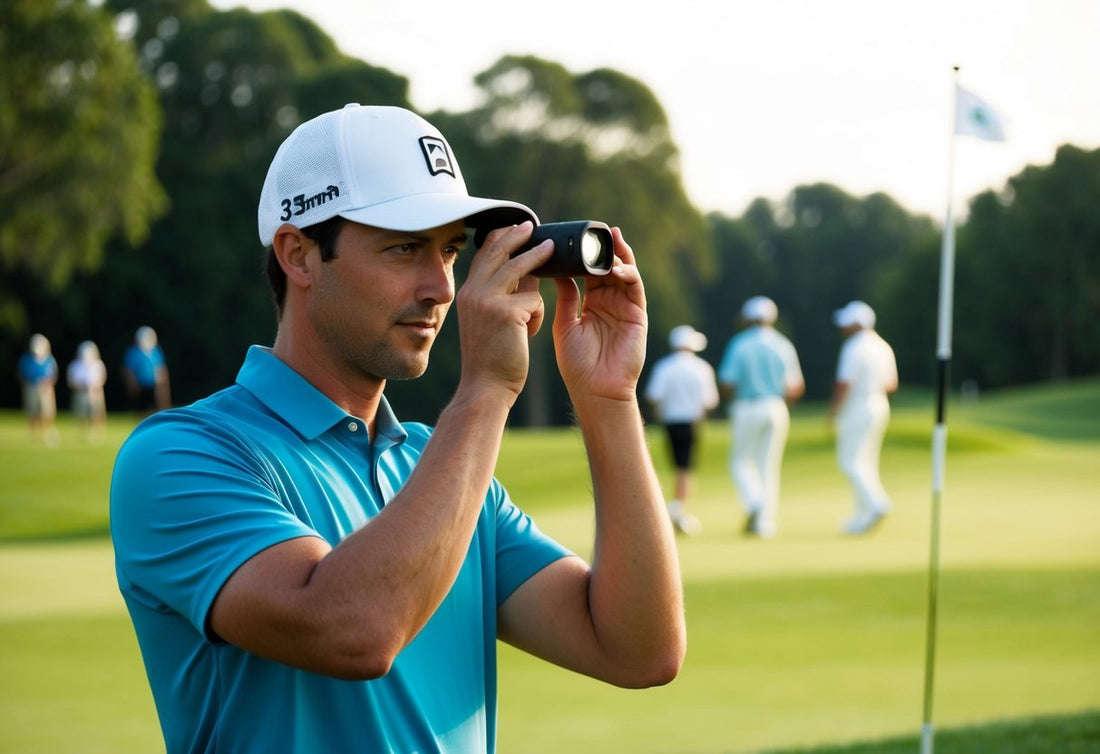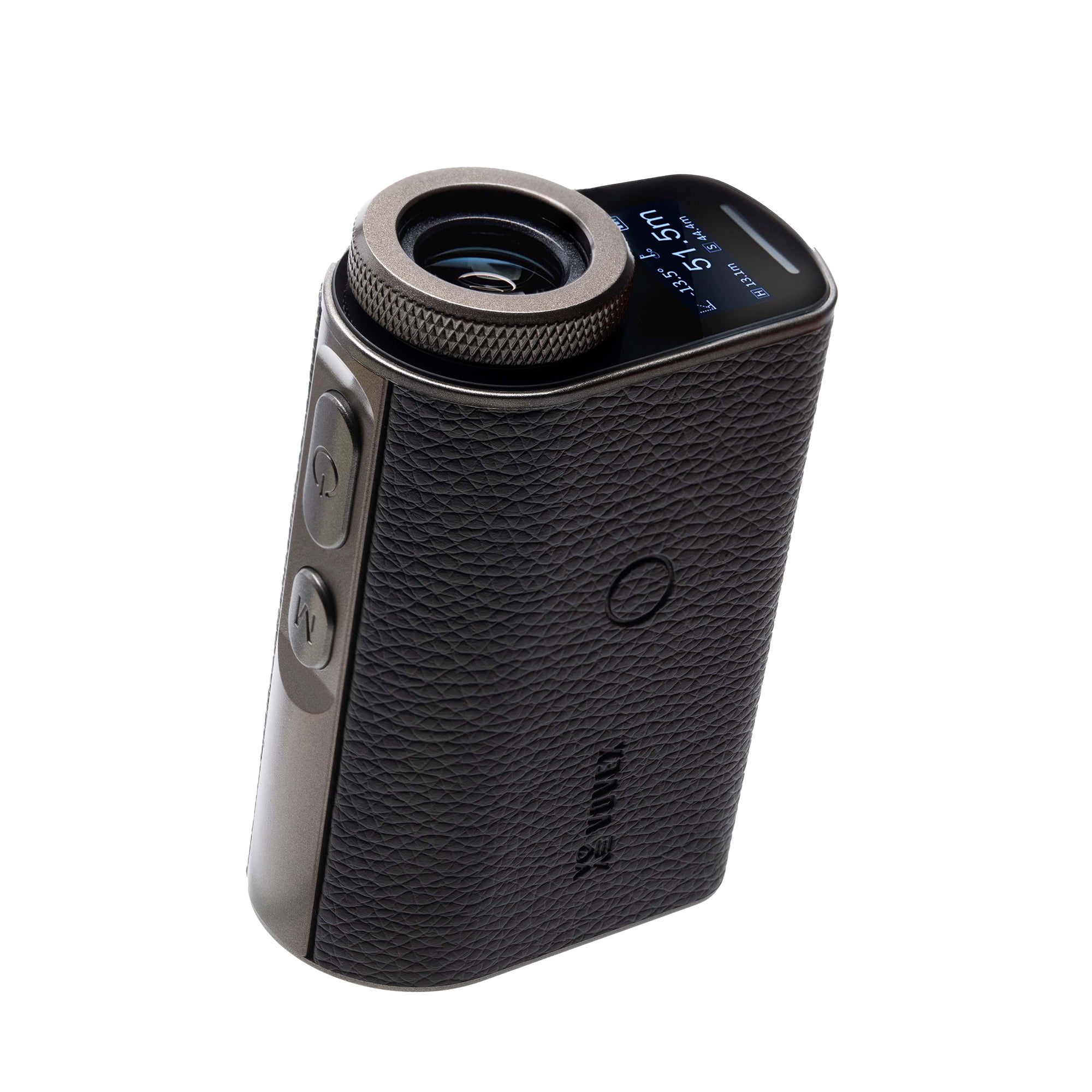Check out our golf rangefinders by Vovex to elevate your game!
Choosing the right distance measurement tool can dramatically impact your golf game, whether you're a casual weekend player or a competitive enthusiast. Laser and GPS rangefinders each offer unique benefits that cater to different playing styles, course conditions, and personal preferences.
The best rangefinder choice depends primarily on your playing style: laser rangefinders excel in precision and versatility for detail-oriented players, while GPS units offer comprehensive course mapping and faster readings for those who prioritize pace of play. We've spent countless hours testing both technologies across various courses and weather conditions to bring you this comprehensive comparison.
When selecting between these technologies, consider what matters most in your game—pinpoint accuracy, course management features, or perhaps the ability to function in foggy conditions at your local links. The right choice will not only improve your distance calculations but could potentially shave strokes off your score.
Key Takeaways
- Laser rangefinders provide superior accuracy to specific targets while GPS units offer broader course information without needing line of sight.
- GPS devices generally support faster play with instant readings, while lasers may require more time but deliver more precise measurements.
Understanding Laser Rangefinders
Laser rangefinders have revolutionized distance measurement in golf, offering precision that was previously unavailable to the average player. These devices have become essential tools for serious golfers who need exact yardages to execute their shots with confidence.
How They Work
Laser rangefinders use a simple yet effective principle of physics. When activated, they emit an invisible, narrow laser beam that bounces off the target and returns to the device. The rangefinder calculates the distance by measuring the time it takes for the laser to return.
This process happens almost instantaneously, giving you immediate feedback on flag distances. Most modern laser rangefinders can measure with accuracy to within 1 yard or less. The technology focuses on specific targets, which means you can precisely pick out the flagstick even when it's positioned against trees or other background elements.
Many premium models now include slope functionality, which factors in elevation changes to provide adjusted distances. This feature can be toggled off for tournament play where slope calculations aren't permitted under the Rules of Golf.
Pros and Cons
Pros:
- Pinpoint Accuracy: Laser rangefinders excel at providing exact distances to flags, hazards, and other specific targets.
- No Course Downloads: They work on any course without requiring pre-loaded maps or subscriptions.
- One-time Purchase: After buying the device, there are no additional fees or updates needed.
- Quick Readings: Most lasers provide distances in seconds, keeping pace of play moving.
Cons:
- Line of Sight Required: You must have visual access to your target, making them less effective in fog, rain, or for blind shots.
- Shaky Hands Issue: Some golfers struggle to hold the device steady enough for accurate readings.
- Limited Information: They only provide distance to targeted objects, not comprehensive hole layouts.
Battery life can also be a consideration, with most units requiring replacement or recharging after 15-20 rounds.
Understanding GPS Rangefinders
GPS rangefinders have revolutionized distance measurement on golf courses by providing accurate yardages without needing to target specific objects. They offer convenience and comprehensive course information that many players find invaluable during their rounds.
How They Operate
GPS rangefinders work by utilizing satellite technology to pinpoint your exact location on the golf course. These devices come preloaded with thousands of course maps stored in their memory. When you're playing, the unit compares your current position to the stored map data.
Unlike laser rangefinders, GPS units don't require a clear line of sight. They automatically calculate distances to preset points like the front, middle, and back of greens. Many modern GPS devices feature color touchscreens that display detailed hole layouts.
The technology has evolved tremendously in recent years. We've seen GPS units shrink from handheld devices to watches and even small clip-on units that attach to your hat or belt. Some advanced models offer additional features like shot tracking, score keeping, and even swing analysis.
Pros and Cons
Pros:
- Convenience: Just glance at the screen for instant distances without aiming
- Comprehensive data: Provides distances to hazards, layup points, and doglegs
- Speed of play: Significantly faster than laser measurement for most golfers
- Works everywhere: Effective in fog, rain, or when the flag isn't visible
- Extra features: Many units offer stat tracking and course management tools
Cons:
- Subscription fees: Some units require annual fees for updated course maps
- Battery life: Generally requires charging after 1-2 rounds
- Less precision: Typically accurate to 3-5 yards rather than 1 yard with lasers
- Preset points only: Can't measure to specific targets not in the course map
- Tournament restrictions: Some competitions prohibit advanced GPS features
GPS units excel for golfers who value convenience and course management over pinpoint precision. We find them particularly useful on unfamiliar courses where knowledge of hazard distances and green depths provides a significant advantage.
Comparing Accuracy
When it comes to distance measurement on the golf course, accuracy is paramount. The difference of just a few yards can significantly impact club selection and strategy.
Laser Precision
Laser rangefinders deliver exceptional point-specific accuracy, typically within ±1 yard of the actual distance. This precision is hard to beat when you need exact measurements to specific targets. We've found that premium models like Bushnell Pro XE and Nikon Coolshot can achieve accuracy within half a yard in optimal conditions.
The key advantage is the ability to pick out precise points - bunker edges, trees, or the flagstick itself. On challenging holes with multiple hazards, this specificity becomes invaluable.
Weather conditions can occasionally impact performance. Fog, heavy rain, or extremely bright sunlight might make it difficult to lock onto targets. Some golfers also find that steady hands are necessary for consistent readings.
GPS Consistency
GPS rangefinders provide remarkable consistency, typically accurate to within 3-5 yards. While less precise than lasers, this level of accuracy is sufficient for most amateur golfers' needs.
The primary advantage of GPS units is their reliability regardless of line-of-sight issues. They'll give you center-green distances even when you can't see the flag from your position. Many modern GPS watches and handheld devices also offer front/middle/back green readings automatically.
Course mapping quality varies between brands and devices. Premium options like Garmin Approach and SkyCaddie use professional course mapping techniques to enhance accuracy. Most GPS units update their readings every 1-2 seconds, providing near-instant distance information as you walk the course.
Unlike lasers, GPS accuracy isn't affected by shaky hands or weather conditions, though dense tree cover can occasionally interfere with satellite signals.
Ease of Use on the Course
How quickly you can get accurate yardages on the course significantly impacts your pace of play and confidence over shots. The learning curve and accessibility of different rangefinder types can make a substantial difference in your overall experience.
Laser Learning Curve
Laser rangefinders require a steady hand and some practice to master. We've found that most golfers need 2-3 rounds to become comfortable with acquiring targets quickly. The main challenge is keeping the device still enough while pressing the button to get an accurate reading.
Wind and fatigue can make this more difficult, especially toward the end of your round. Many newer models include stabilization technology that helps compensate for minor hand movements.
Premium lasers from Bushnell and Precision Pro now feature "lock-on" technology that vibrates when you've successfully captured the flag, making the learning process much easier. Most golfers can get readings within 5-7 seconds once they've developed the proper technique.
GPS Accessibility
GPS units offer superior ease of use right out of the box. With preloaded courses and automatic hole advancement, most golfers can use a GPS device effectively on their first round. No aiming required - simply glance at your device for instant yardages.
Wearable GPS options like watches allow for one-handed operation while walking to your ball. This convenience factor is significant when playing in cart-path-only conditions or walking the course.
Battery life is another accessibility advantage. Most GPS units last 2-3 full rounds between charges, while laser devices typically need fresh batteries every 10-15 rounds. However, GPS devices require occasional course updates, which might need computer access or smartphone connectivity.
Speed of Play
The choice between laser and GPS rangefinders can significantly impact your pace on the course. Time management is crucial in golf, especially during busy weekend rounds or tournament play.
Laser Speed Factors
Lasers require a steady hand and clear line of sight to your target. This setup process typically takes 5-10 seconds per measurement, which can add up throughout your round. We've found that most golfers need to take multiple readings for accuracy, especially in windy conditions.
Players often measure to various targets (bunkers, water hazards, front/middle/back of green), potentially adding 1-2 minutes per hole. Practice improves efficiency dramatically - experienced users can cut measurement time in half.
Some newer laser models include "scan mode" features that allow continuous measurements while panning across the landscape. This innovation has significantly improved the speed factor for laser users.
GPS Time Efficiency
GPS units provide instant readings with a quick glance. Most devices display front/middle/back green distances simultaneously, eliminating the need for multiple measurements.
A key time-saving advantage is the ability to see distances without line-of-sight to the target. You'll get readings in seconds even when playing blind shots or when obstacles block your view.
Premium GPS watches and handhelds automatically advance to the next hole, further streamlining the process. We've timed many rounds and found GPS users save 3-5 minutes per round compared to laser users.
The tradeoff comes with specialty shots where precise distances to specific hazards might require navigating through menu screens, potentially slowing play momentarily.
Environmental Factors
Weather conditions and surroundings significantly impact both laser and GPS rangefinders on the golf course, often determining which technology performs better when you need it most.
Impact on Laser Performance
Laser rangefinders struggle in fog, rain, and low-light conditions. The laser beam requires a clear path to bounce off its target and return to the device. In heavy rain or dense fog, accuracy drops dramatically as water particles scatter the beam.
Bright sunlight can also create challenges by making it difficult to see the viewfinder display. We've found that even slight hand tremors become magnified in these conditions, making it harder to maintain a steady aim at your target.
Trees and bushes present another obstacle. When trying to measure distance to a flagstick, an errant laser might catch a branch or leaf instead, giving you an incorrect reading. This happens more often than manufacturers like to admit.
GPS Reliability
GPS rangefinders remain largely unaffected by weather conditions. Rain, fog, and darkness don't impact satellite signal reception, allowing for consistent performance in challenging weather. This reliability is a major advantage when playing in changeable conditions.
However, GPS units face their own challenges. Tree canopies and tall buildings near courses can occasionally block satellite signals, causing temporary accuracy issues. Some remote courses with poor satellite coverage may show slightly less precise readings.
Battery life tends to suffer in extreme cold, so keep your GPS device warm during winter rounds. Most modern units will function for at least one full round, but older models might need charging midway through in freezing temperatures.
Signal strength can vary between different golf course locations, with some rural courses experiencing slightly weaker connections than those in more developed areas.
Battery Life and Durability
When selecting between laser and GPS rangefinders, battery performance and durability become critical factors that can make or break your experience on the course. Different technologies create distinct power demands and maintenance needs.
Laser Endurance
Laser rangefinders typically offer excellent battery life, with most models running on CR2 lithium batteries that last for 2-3 months of regular play. We've found that premium models like Bushnell Pro XE can deliver up to 200+ rounds on a single battery. The power-saving advantage comes from their on-demand operation - they only consume power when actively measuring distances.
Most laser units feature water-resistant construction rather than being fully waterproof. The Precision Pro NX9 stands out with its IPX7 rating, surviving temporary immersion in water.
Laser Battery Tips:
- Always carry a spare CR2 battery in your bag
- Turn off after each measurement to maximize battery life
- Store in dry conditions to prevent internal corrosion
GPS Battery Considerations
GPS rangefinders demand more power due to constant satellite communication and screen displays. Most handheld GPS units provide 10-15 hours of continuous use per charge. Watch-style GPS devices typically need recharging every 2-3 rounds.
The advantage of GPS units is their rechargeable lithium-ion batteries. However, this means you'll need to plan ahead to ensure your device is charged before heading to the course.
Many newer GPS models incorporate power-saving features like automatic screen dimming and standby modes. The Garmin Approach S62, for example, can extend battery life by disabling certain features when not needed.
Durability varies significantly across brands, with premium models offering IP68 ratings to withstand dust, rain, and occasional submersion. Budget-friendly options typically provide basic splash resistance but may not survive heavy downpours.
Course Availability and Mapping
The availability of course information dramatically impacts the effectiveness of rangefinders on the golf course. Different technologies offer varying levels of accessibility and detail when it comes to mapping courses worldwide.
Laser Universality
Laser rangefinders shine in their universal applicability across any golf course. We've found they work seamlessly whether you're playing at your local municipal course or visiting a prestigious championship venue. No downloads, subscriptions, or updates are required.
This plug-and-play functionality makes lasers particularly valuable for golfers who frequently play new or less popular courses. Even on newly constructed holes or temporarily redesigned layouts, laser rangefinders perform flawlessly.
The technology works by simply measuring what you can see, meaning course recognition is never an issue. This universal compatibility is especially beneficial for travelers who play internationally, where GPS coverage might be limited or outdated.
GPS Course Downloads
GPS units typically rely on preloaded course maps or downloadable content. Most premium GPS devices come with 30,000-40,000 courses worldwide, covering the vast majority of established facilities.
New courses, however, may experience delays before appearing in GPS databases. We've noticed that popular courses receive faster updates, while less-frequented venues might wait longer for accurate mapping.
Many GPS manufacturers offer subscription services for the most up-to-date course information. These services typically cost $20-50 annually depending on the provider and coverage level.
The quality of course mapping varies significantly between brands. Premium units offer hole flyovers, detailed hazard information, and even green undulation data. Budget options might only provide basic front/middle/back green distances.
Connectivity is another consideration. Some units require smartphone pairing for course downloads, while others have built-in cellular or Wi-Fi capabilities for independent updates.
Cost Analysis
Budget considerations often drive purchasing decisions for golf rangefinders. The price difference between laser and GPS options can be substantial, with several factors affecting long-term value.
Investing in Laser Tech
Laser rangefinders typically require a higher initial investment than their GPS counterparts. Entry-level models from reputable brands like Bushnell and Nikon start around $200, while premium options with slope technology can exceed $500.
The good news? Laser rangefinders have no subscription fees or ongoing costs. Once you purchase the device, it's yours to use without additional expenses.
Battery life is another cost consideration. Most laser models use replaceable CR2 batteries that last 2-3 months of regular play. A pack of these batteries costs about $10-15, adding roughly $30-45 to your annual maintenance costs.
Long-term value factors:
- No subscription fees
- 3-5 year typical lifespan
- Minimal maintenance costs
- Retains resale value better than GPS
GPS Price Points
GPS rangefinders offer a more accessible entry point, with basic handheld units starting around $100-150. Mid-range models with color displays and preloaded courses run $150-250, while premium watch-style GPS devices can reach $300-500.
Unlike laser rangefinders, many GPS options require subscription fees for premium features or course updates. These typically range from $30-50 annually, adding to the total cost of ownership.
GPS units generally use rechargeable batteries, eliminating replacement costs. However, battery degradation over time may require device replacement after 2-3 years of heavy use.
GPS cost considerations:
| Item | Approximate Cost |
|---|---|
| Entry-level handheld | $100-150 |
| Mid-range color display | $150-250 |
| Premium GPS watch | $300-500 |
| Annual subscription | $30-50 |
We've found that serious golfers who play the same courses regularly get better long-term value from laser rangefinders despite the higher upfront cost.
Choosing the Best Fit for Your Play Style
Selecting between laser and GPS rangefinders ultimately comes down to how you approach the game and where you typically play. Your personal goals and travel habits will significantly influence which technology serves you best on the course.
Personal Performance Goals
If precision is your priority, laser rangefinders offer unmatched accuracy. We've found that players focused on shaving strokes off their game benefit from knowing distances within half a yard.
Competitive players who need exact measurements to hazards and pins will appreciate the laser's pinpoint capabilities. The confidence that comes from knowing exactly how far you need to hit is invaluable in tournament situations.
GPS units shine for strategic golfers who plan their approach shots carefully. With comprehensive hole layouts and multiple distance readings, they help you visualize the entire hole before swinging.
Quick Decision Guide:
- Choose Laser if you're focused on exact yardages and improving your approach accuracy
- Choose GPS if course management and strategic play define your game
Frequent Courses and Travel
Golfers who play the same few courses repeatedly often find lasers more economical long-term. There's no subscription to maintain, and the device works identically whether you're at your home course or on vacation.
GPS units truly excel for travelers who play many different courses. Having instant access to thousands of pre-loaded course maps eliminates the learning curve when playing somewhere new.
Consider battery life in your decision. We've noticed that during golf trips, GPS watches offer multi-round convenience without charging, while laser devices might need replacement batteries.
Weather considerations matter too. Playing in foggy regions? GPS functions regardless of visibility conditions, while lasers struggle when you can't clearly see targets.
Frequently Asked Questions
Golfers face numerous questions when deciding between laser and GPS rangefinders. These common inquiries address precision, functionality, compatibility, cost considerations, and recent technological improvements that impact performance on the course.
What makes a golf laser rangefinder superior in precision compared to GPS devices?
Laser rangefinders deliver unmatched accuracy within 1 yard of the target. This precision comes from the device's ability to send a laser beam directly to the flagstick and measure the exact time it takes to return.
Unlike GPS units that rely on satellite coordinates, lasers measure actual distance to any visible object. This makes them particularly valuable when you need precise distances to hazards or other course features not typically mapped in GPS systems.
The focused beam technology also means you're getting the distance to exactly what you're aiming at, not a pre-mapped point. This becomes crucial when pin positions change daily on greens.
How do the functionalities of a GPS golf watch enhance a player's game on the course?
GPS watches provide comprehensive course mapping with distances to hazards, doglegs, and green fronts/backs at a glance. This instant availability of multiple distances helps with strategic club selection without needing to shoot multiple targets.
Many modern GPS units include shot tracking, scoring, and swing analysis features. These added capabilities transform them from simple distance tools into complete game management systems.
The hands-free nature of GPS watches keeps pace of play moving smoothly. We've found players save 15-20 minutes per round compared to those constantly pulling out and replacing a laser device.
Can golfers leverage the benefits of both laser rangefinders and GPS devices during play?
Absolutely! Many tour professionals and serious amateurs use both technologies strategically. GPS provides quick overview distances while approaching holes, while lasers deliver pin-point accuracy for approach shots.
The complementary approach works particularly well on unfamiliar courses. GPS helps with overall hole strategy and hazard avoidance, while laser confirms exact distances when precision matters most.
Storage isn't an issue as GPS watches stay on your wrist while compact laser units easily attach to bags or carts. The dual-technology approach does require a higher investment but offers comprehensive distance coverage.
What are the cost differences between top-tier golf laser rangefinders and GPS watches?
Premium laser rangefinders typically range from $300-500, with high-end models featuring slope adjustment and locking vibration. These devices rarely require subscription fees and maintain value over several seasons.
GPS units vary more widely, with basic handheld units starting around $150 and advanced watches reaching $400-600. Some manufacturers charge annual subscription fees of $30-50 for updated course information.
When comparing total cost of ownership, lasers generally prove more economical long-term. GPS technology becomes outdated faster and may require course map updates, while laser measuring technology remains consistent for years.
How does a golfer's play style influence the choice between laser rangefinders and GPS technology?
Aggressive players who attack pins benefit tremendously from laser precision. The exact distance knowledge allows confident club selection when targeting specific parts of greens.
Strategic players who focus on positioning often prefer GPS. The ability to see multiple distances simultaneously helps with layup decisions and avoiding hazards.
Course familiarity also influences the decision. Golfers who regularly play the same courses may find GPS more convenient, while those who play various courses benefit from the adaptability of lasers to any location.
What advancements have been made in the accuracy of golf GPS devices in recent years?
GPS accuracy has improved dramatically with multi-satellite connectivity that triangulates position within 2-3 yards in optimal conditions. This represents a significant improvement over earlier models that could be off by 5-7 yards.
High-refresh rate technology now updates distances continuously as you move. This dynamic measurement provides more accurate information compared to older units that refreshed every 10-15 seconds.
Advanced mapping techniques now include detailed green contours and playing surfaces. The latest premium units show actual green shapes and allow manual pin placement for even greater distance precision to the day's hole location.






